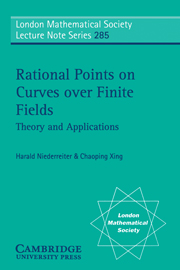Book contents
- Frontmatter
- Contents
- Preface
- 1 Background on Function Fields
- 2 Class Field Theory
- 3 Explicit Function Fields
- 4 Function Fields with Many Rational Places
- 5 Asymptotic Results
- 6 Applications to Algebraic Coding Theory
- 7 Applications to Cryptography
- 8 Applications to Low-Discrepancy Sequences
- A Curves and Their Function Fields
- Bibliography
- Index
8 - Applications to Low-Discrepancy Sequences
Published online by Cambridge University Press: 05 April 2013
- Frontmatter
- Contents
- Preface
- 1 Background on Function Fields
- 2 Class Field Theory
- 3 Explicit Function Fields
- 4 Function Fields with Many Rational Places
- 5 Asymptotic Results
- 6 Applications to Algebraic Coding Theory
- 7 Applications to Cryptography
- 8 Applications to Low-Discrepancy Sequences
- A Curves and Their Function Fields
- Bibliography
- Index
Summary
In the theory of uniform distribution of sequences in number theory and also in quasi-Monte Carlo methods in numerical analysis, one of the key problems is to distribute points as uniformly as possible over a unit cube of arbitrary dimension. The precise formulation of this problem leads to the concept of star discrepancy and to the requirement of constructing low-discrepancy point sets and sequences. There are several classical constructions of low-discrepancy sequences, and consequently of low-discrepancy point sets, but by far the most powerful construction methods were developed recently and they are based on global function fields, in particular on global function fields with many rational places. These methods improve on all previous methods of obtaining low-discrepancy sequences and yield, in fact, low-discrepancy sequences with parameters which are best possible in terms of their order of magnitude. In this chapter we first present the relevant background on star discrepancy and on the theory of (t, m, s)-nets and (£, s)-sequences. Then we (describe in detail two construction principles for low-discrepancy sequences that depend in an essential way on the choice of suitable places of global function fields.
- Type
- Chapter
- Information
- Rational Points on Curves over Finite FieldsTheory and Applications, pp. 191 - 218Publisher: Cambridge University PressPrint publication year: 2001



